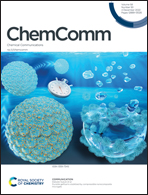Gauging the donor strength of iron(0) complexes via their N-heterocyclic carbene gold(i) adducts†
Abstract
We isolate and characterize the gold(I)–iron(0) adducts [(iPr2-bimy)Au–Fe(CO)3(PMe3)2][BArF4] and [Au–{Fe(CO)3(PMe3)2}2][BArF4] (iPr2-bimy = 1,3-diisopropylbenzimidazolin-2-ylidene, BArF4 = tetrakis(pentafluorophenyl)borate). DFT analysis reveals that the gold–iron interaction in [(iPr2-bimy)Au–Fe(CO)3(PMe3)2][BArF4] is predominantly a σ-donation from iron to gold. We further extend this class of compounds to include [(iPr2-bimy)Au–Fe(CO)3(PR3)2][BArF4] (PR3 = PPh3, PCy3, PCyPh2, PMePh2, PMe2Ph, P(4-C6H4F)3) and [(iPr2-bimy)Au–Fe(CO)4(PPh3)][BArF4] and correlate the iPr2-bimy carbenic 13C NMR signal with the relative donor strength of the iron(0) ligand. This approach allows for a fast and simple approach to gauge relative donor strength of Fe(0) donors.



 Please wait while we load your content...
Please wait while we load your content...